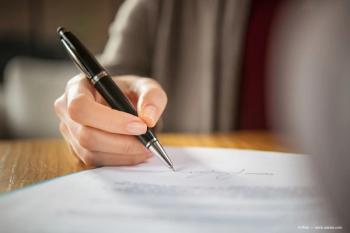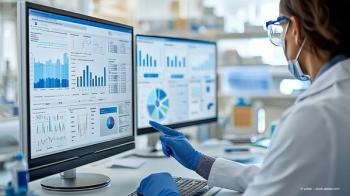
Five strategic ways to care for older patients with advanced dry eye
Editor’s Note: Welcome to “Eye Catching: Let's Chat,” a blog series featuring contributions from members of the ophthalmic community. These blogs are an opportunity for ophthalmic bloggers to engage with readers with about a topic that is top of mind, whether it is practice management, experiences with patients, the industry, medicine in general, or healthcare reform. The series continues with this blog by Alan B. Richards, MD. The views expressed in these blogs are those of their respective contributors and do not represent the views of Ophthalmology Times or UBM Medica.
Many older patients are told that their dry, red eyes are just a part of getting older, like aching knees or gray hair. It’s true-patients over 60 are far more likely to have dry eye than people under 30, but, like aching knees and gray hair, dry eye is treatable.
When these patients enter our practices, feeling uncomfortable and frustrated, unable to do the activities they love, and often repeatedly brushed off by other doctors, we need to convey that they’ve finally come to the right place. Though age is a factor in dry eye disease, it is certainly no reason to dismiss it.
In my practice, our words and actions convey our knowledge that dry eye disease is a real, well-understood, and objectively measured problem, and that we are a caring, experienced place to receive treatment.
The following strategies can help you convey those messages to patients of any age, but they are especially helpful for patients who have struggled over time with more advanced dry eye disease.
- 1. Offer the empathy and compassion they’ve missed
The average dry eye patient at my clinic has seen 3.2 other eye-care professionals in the past 3 years. Those doctors often dismissed the problem as common and “no big deal” or worse, treated patients like “they’re crazy” and it’s “all in their heads.”
They tell patients to use artificial tears and deal with it on their own, but these people are suffering, so they seek out someone else for the same complaints.
When patients find us, we want them to know that this is their last stop-they have found people who respect and understand what they are experiencing and know how to treat it. Conversations among doctors, patients, and staff are aimed at conveying compassion, empathy, and understanding about the effect of dry eye disease on people’s lives.
- 2. Take a history that informs both of you
Our process for taking a dry eye history conveys the same knowledge and compassion we demonstrate throughout the patient experience. To help us determine the type of dry eye and severity of the symptoms, we ask a series of yes-or-no questions such as, “Have you ever noticed your eyes are red? Are they sometimes dry and sandy or gritty? Does your vision start out fine, and then get blurry? Does it sometimes feel like there’s something in your eye? Do artificial tears last a few minutes, and then wear off?”
When patients who have been told that their symptoms are imagined or unimportant hear questions that validate those symptoms, they know that I understand the condition and the reasons behind it. This gives my patients a sense of confidence and reassurance that the diagnosis and treatment will actually offer results.
It’s a nice contrast for patients to finally feel they will be treated properly. The approach also works well for older patients because it is verbal, rather than written, and the yes-or-no answers are an easy and efficient manner by which we convey understanding while uncovering pertinent and diagnostically helpful symptoms.
- 3. Convey a clear, objective picture of dry eye disease
For years, dry eye disease had the reputation in our profession of being murky and subjective, with no concrete definition or testing and few good ways to resolve patients’ complaints. That was then, and this is now. Dry eye is real, clearly defined, and measurable, and we can treat it effectively.
We need to convey that very plainly to patients. They don’t want to hear that their problem is very complicated, particularly in the case of older patients who may already be dealing with complex health problems.
I explain to patients that dry eye is a single inflammatory disease, with a spectrum of severity or longevity. This framework helps us to more easily understand the disease and target therapies to each patient. In my practice, we diagnose each patient’s disease state with a standardized approach to patient history, point-of-care testing, and dry eye examination.
- 4. Beyond diagnosis, use testing to educate and galvanize patients
We continue to demonstrate our understanding of dry eye disease with a thorough testing and examination process, and we use the results to educate patients and ensure their buy-in for treatment.
Our standard battery of testing includes tear breakup time, corneal staining and testing for the MMP-9 inflammatory mediator (InflammaDry, Quidel). If the patient has meibomian gland dysfunction, we do meibography imaging of the glands (LipiScan, Johnson & Johnson Vision).
A thorough slit lamp examination and inspection of the meiboman glands and lid margins are key parts of the dry eye exam. As I talk to patients, I tell them how their MMP-9 numbers compare with normal eyes. I show them images of their blocked or missing meibomian glands alongside an image of healthy glands.
This evidence that their problem is real and measurable encourages their investment in the next step, which is to talk about treatment. A slit lamp photo of their staining pattern, blepharitis, or presence of conjunctivochalasis is often all that is needed to attain patient acceptance of treatment recommendations and better compliance.
- 5. Explain how recommend treatments work
By the time I discuss treatment options for dry eye, patients are already confident that I understand the problem. I’ve shown them the evidence. As a result, they are accepting and even enthusiastic about treatment.
Home care regimens are still part of the recommendation, but for patients with more advanced disease, I often recommend prescription medication and a synergistic combination of intense pulsed light therapy (IPL) (M22 OPT, Lumenis) and thermal pulsation therapy (LipiFlow, Johnson & Johnson Vision).
It’s important to take time to explain why this treatment approach might help them where other therapies have failed. I explain to my patients that cyclosporine (Restasis, Allergan) or lifitigrast (Xiidra, Shire) will help the eyes produce more tears with less inflammation, addressing they aqueous deficient component of dry eye.
IPL is a series of light-based treatments that address the inflammatory component of dry eye by treating the capillaries on the eyelids and eye area that promote inflammation, meibomian gland clogging, and pathological changes to the quality and characteristics of the meibum.
Thermal pulsation therapy is a heated massage that addresses the lipid layer of the tear film, thinning meibomian gland secretions and allowing for easier and more thorough expression.
Patients tend to be happy that we’re taking a different approach from previous doctors. In many cases, older patients have had dry eye disease for decades, and they are ready for some relief.
Know Your Older Patients
In addition to walking older patients through the process of diagnosis and treatment for dry eye, it helps to understand how their disease might differ from their younger counterparts.
There is a good chance that medications or underlying systemic conditions could be contributing to their dry eye. They could have a neurotrophic cornea or mechanical problems such as conjuctivalcholasis.
My older patients frequently have foreign body sensation and watery eyes. Visual symptoms are significant – some patients without visually significant cataracts think they need cataract surgery because of the effects of dry eye.
By being the doctor who finally understands and educates them about their disease, you can relieve their stress and frustration and give them the care they deserve.
Neel R. Desai, MD
Dr. Desai is the director of the Cornea, Cataract, and Refractive Services at The Eye Institute of West Florida, Medical Director of the Lions Eye Institute for Transplant Research, and President and CEO of Clarity Visionary Consulting.
Disclosures:
Dr. Desai is a consultant to Lumenis, TearLab and Johnson & Johnson Vision.
Newsletter
Don’t miss out—get Ophthalmology Times updates on the latest clinical advancements and expert interviews, straight to your inbox.



















































.png)


